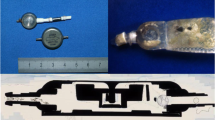Summary
The reactions of periventricular tissue of the lateral ventricle to non-infected and infected (Staphylococcus Epidermidis) silicone shunt tubing were examined by light and transmission electron microscopy. It was shown that reactive changes occurred in periventricular tissue in response to the implant of sterile shunt tubing. On the other hand in infected implanted silicone shunt tubing, proliferation of inflammatory cells within the ventricle and periventricular tissue, loss of integrity of the ependyma, glial cell proliferation, and excessive extracellular oedema were demonstrated. Proliferation of ependymal cells combined with inflammatory responses may be a factor in the pathogenesis of infected shunt obstruction.
Similar content being viewed by others
References
Alvarez-Garijo JA, Mengual MV (1982) Infection rate with and without prophylactic antibiotic therapy after shunt insertion for hydrocephalus. In shunts and problems in shunts. Monogr Neural Sci 8: 66–68
Betty MJ (1977) Ependymal hyperplasia in the lateral ventricle of the quinen-pig. J Comp Pathol 87: 185–191
Bruni JE, Clattenburg RE, Paterson JA (1983) Ependymal cells of the rat fourth ventricle: response to injury. Scanning Electron Microsc 2: 649–661
Bruni JE, Del Bigio MR (1986) Reaction of periventricular tissue in the rat fourth ventricle to chronically placed shunt tubing implants. Neurosurgery 19: 337–345
Cavanagh JB (1970) The proliferation of astrocytes around a needle wound in the rat brain. J Anat 106: 471–487
Collins P, Bockley AD, Woollam DMH (1978) Surface ultrastructure of tissues occluding ventricular catheters. J Neurosurg 48: 609–613
Del Bigio MR, Bruni JE (1986) Reaction of rabbit lateral periventricular tissue to shunt tubing implants. J Neurosurg 64: 932–940
Forward KR, Fewer HD, Stiver GH (1983) Cerebrospinal fluid shunt infections. A review of 35 infections in 32 patients. J Neurosurg 59: 389–394
Giuffre R (1976) Choroidal and ependymal reactions. J Neurosurg Sci 20: 123–129
Go KG, Ebels EJ, van Woerden H (1981) Experiences with recurring ventricular catheter obstructions. Clin Neurol Neurosurg 83: 47–56
Gombert ME, Landesman SH, Corrado ML, Stein SE, Melvin ET, Cumming JM (1981) Vancomycin and ripampin therapy for Staphylococcus epidermidis meningitis associated with CSF shunts. J Neurosurg 55: 633–636
Hainess SJ, Taylor F (1982) Prophylactic methicillin for shunt operations. Effects on shunt malfunction and infection. Childs Brain 9: 10–22
Hetzel W (1978) Ependymal structures of the anterior and inferior horn of the lateral ventricles of the rabbit brain. Scanning Electron Microsc 2: 129–136
Hirsch JF, Hirsch EH (1988) Shunts and shunts problems in childhood. In: Symon Let al (eds) Advances and technical standards in neurosurgery, Vol 16. Springer, Wien New York, pp 177–196
Hockley AD (1982) Histological response to ventricular cather. Monogr Neurol Sci 8: 63–65
Occhipirti E, Fontana M, Giuffre R, Palma L (1980) Biological shunt complications. Adv Neurosurg 8: 195–198
Page RB, Rosenstein JM, Leure de Pree AE (1979) The morphology of extrachoroidal ependyma overlying gray and whitemater in the rabbit lateral ventricle. Anat Rec 194: 67–81
Renier D, Lacombe J, Pierre-Khan A, Sainte Rose C, Hirsh JF (1984) The factors of acute shunt infection. A computer analysis of 1174 operations. J Neurosurg 61: 1072–1078
Reinhardt V, Nau HE (1980) Histological investigations and clinical considerations on shunt dysfunctions. In: Grote W, Brock M, Clar HE,et al (eds) Surgery of cervical myelopathy. Infantile hydrocephalus: long-term results. Advances in neurosurgery, Vol 8. Springer, Berlin Heidelberg New York, pp 267–272
Schoenbaum CS, Gardner P, Schillito J (1975) Infections of cerebrospinal fluid shunts. Epidemiology, clinical manifestations and therapy. J Infect Dis 131: 543–552
Sekhar LN, Moossy J, Guthkelch AN (1982) Malfunctioning ventriculoperitoneal shunts. Clinical and pathological features. J Neurosurg 56: 411–416
Shamsuddin D, Tuazon UC, Miller H (1983) Experimental Staphylococcus epidermidis endocarditis in rabbit model. Arch Pathol Lab Med 107: 141–143
Shulman JA, Nahmias AJ (1972) Staphylococcal infections. Clinical aspects. In: Cohen JO (eds) The Staphylococcus. Wiley, New York, pp 497–502
Walters BC, Hoffman HJ, Hendrich EB, Hemphroys RP (1984) Cerebrospinal fluid shunt infection. Influences on initial management and subsequent outcome. J Neurosurg 60: 401–402
Author information
Authors and Affiliations
Rights and permissions
About this article
Cite this article
Gedikoglu, Y., Çolak, A., Benli, K. et al. Reaction of rabbit lateral periventricular tissue to non-infected and infected (Staphylococcus Epidermidis) shunt tubing implants. Acta neurochir 122, 266–270 (1993). https://doi.org/10.1007/BF01405540
Issue Date:
DOI: https://doi.org/10.1007/BF01405540




